The song “Houses Sing,” by Texas singer/songwriter Danny Schmidt, reminds me of the people who built the first houses here and how new neighbors have continued to regenerate them. Here are just a few of the words:
There’s signs in all the yards, with a price tag and a plea.
And I can see my daughter swinging, in the shade of every tree.
Every building tells a story, every builder holds a pen.
They only tell beginnings, they’re yours to tell the end . . .
Can’t you hear them houses sing?
I can hear them houses sing.
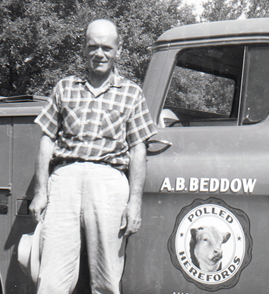 Longtime neighbors have told us about some of the people who helped build and maintain the neighborhood early on. Beginning about 1947, Alfred B. (A. B.) Beddow Jr. (right) was a realtor and a primary developer of Crestview with Leonard Rayzor (Ray) Yates, who owned several locations of Crestview Builders Supply, including one on Burnet north of 183 that became a nightclub, The Lumberyard, and one on Burnet at Richcreek. (See Yates Avenue.) Both men also sold insurance. A. B.’s wife, Justin Harrison Beddow, helped design some of the homes. (See Justin Lane.) Her brother Wilbert “Cotton” Harrison also was a realtor.
Longtime neighbors have told us about some of the people who helped build and maintain the neighborhood early on. Beginning about 1947, Alfred B. (A. B.) Beddow Jr. (right) was a realtor and a primary developer of Crestview with Leonard Rayzor (Ray) Yates, who owned several locations of Crestview Builders Supply, including one on Burnet north of 183 that became a nightclub, The Lumberyard, and one on Burnet at Richcreek. (See Yates Avenue.) Both men also sold insurance. A. B.’s wife, Justin Harrison Beddow, helped design some of the homes. (See Justin Lane.) Her brother Wilbert “Cotton” Harrison also was a realtor.
Although Beddow and Yates worked together to build Crestview, where they each felt most at home was very different. Crestview neighbor John Carlson worked with both men when they had offices at Crestview Shopping Center. When we interviewed John in September 2009, he remembered this about A. B. Beddow:
He was kind of a gruff fellow, strictly business. He didn’t talk much. When he was away from the office, he was just a plain ordinary guy. I worked on A. B.’s house at his ranch in Garfield, where he raised registered Hereford cattle. He was a different person when he was down there. He was in his element.
 In 1952, Ray Yates and his wife, Maude, built a home at 1313 Richcreek Rd. (right), on the southeast corner of Richcreek and Woodrow. Maude was an avid gardener and longtime member of the Violet Crown Garden Club. In the early 60s, a mature oak tree was slated for removal at Crestview Shopping Center. The tree and the grassy mall where it stood between the two buildings were in the way of a new parking lot being planned there. Maude had the large tree moved, and for many years it has provided welcome shade for outdoor seating at Little Deli.
In 1952, Ray Yates and his wife, Maude, built a home at 1313 Richcreek Rd. (right), on the southeast corner of Richcreek and Woodrow. Maude was an avid gardener and longtime member of the Violet Crown Garden Club. In the early 60s, a mature oak tree was slated for removal at Crestview Shopping Center. The tree and the grassy mall where it stood between the two buildings were in the way of a new parking lot being planned there. Maude had the large tree moved, and for many years it has provided welcome shade for outdoor seating at Little Deli.
After Ray passed away in 1988 and Maude in 1990, her grandson Craig Cherico, a longtime Austin realtor, lived in the Richcreek home until July 2017, when he died. I met Craig when he volunteered at the first Violet Crown Festivals. He later shared with me early records of the Austin Development Company, the firm responsible for developing Crestview beginning in 1947 and owned by Yates and Beddow.
Original Brentwood and Crestview residents from the early 50s remember Robert Jackson McKown as the man who paved streets here. He and his family lived at 1501 Richcreek Road, across Woodrow from the Yates family. McKown built the prominent Crestview home across three lots and moved there with his second wife, Thelma, about 1953. They also were early members of Crestview Baptist Church, two blocks north. R. J. died in 1957 and Thelma in 1968; the McKown family owned the home until the mid-70s.
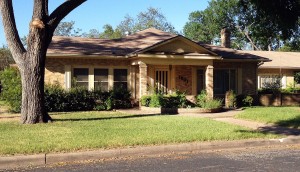 In April 2014, two months before it was demolished, I took the photo of the McKown home, left, along with other photos of original homes, businesses, and churches, as well as newer structures and plantings. My and other neighbors’ photos became part of the City of Austin Community Character in a Box project for Crestview.
In April 2014, two months before it was demolished, I took the photo of the McKown home, left, along with other photos of original homes, businesses, and churches, as well as newer structures and plantings. My and other neighbors’ photos became part of the City of Austin Community Character in a Box project for Crestview.
The City of Austin Historic Landmark Commission considered the home for historic zoning in 2013 and held several hearings. You can learn more about our neighborhood’s efforts to save the home here. The zoning was not approved. The home was demolished in June 2014 and was soon replaced by new construction. The commission’s documentation of the house is on file at the Austin History Center. (Much more about the McKowns and the home below.)
In addition to the McKown and Yates families, the Boemer family has lived on the corner of Woodrow and Richcreek for more than 50 years. Longtime educator Al Boemer is remembered by neighbors as a prolific and generous gardener; today his family continues to plant and maintain the flowers and vegetables in his garden, below.
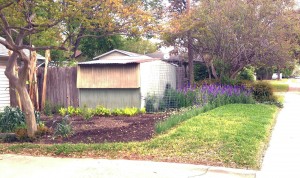 The intersection of Woodrow and Richcreek, where the Boemer, McKown, and Yates families have lived, is the geographic heart of the Crestview neighborhood. Richcreek Road was named for Frank and Julia Richcreek, whose large farm began to be developed as Crestview in the late 40s.
The intersection of Woodrow and Richcreek, where the Boemer, McKown, and Yates families have lived, is the geographic heart of the Crestview neighborhood. Richcreek Road was named for Frank and Julia Richcreek, whose large farm began to be developed as Crestview in the late 40s.
Woodrow Avenue is Brentwood and Crestview’s “main street.” It passes by the mosaic Wall of Welcome, completed in 2008, and by Crestview Shopping Center and neighborhood churches, many built in the 50s and some still thriving today. Woodrow was known by longtime neighbors as “Church Row.”
Johnson Brothers and Howard Pringle, a World War II veteran and Crestview neighbor, built some of the original homes here. Jean Graham created a distinctive Wall of Welcome mosaic for the Pringle home at 1708 Aggie (below). Pringle also built the McKown home formerly at 1501 Richcreek Rd. (it was demolished in 2014).
Carl Einar Stri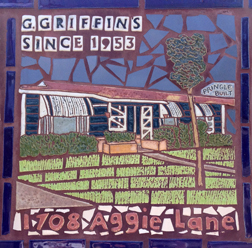 ed, who lived on Richcreek, was lead carpenter for Beddow and Yates. Chester Hjalmar Blomquist Sr.—who had Swedish ancestors, was a World War II veteran, and lived for many years at 1710 Aggie—did tilework.
ed, who lived on Richcreek, was lead carpenter for Beddow and Yates. Chester Hjalmar Blomquist Sr.—who had Swedish ancestors, was a World War II veteran, and lived for many years at 1710 Aggie—did tilework.
C. H. Lester, a dirt excavator, helped grade streets here; he also helped deepen Hancock Creek along Arroyo Seco to improve drainage for the streets and homes being built nearby.
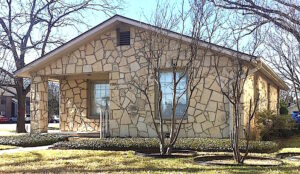 Skilled Austin builder and stonemason and World War II veteran Frank B. Wright (born Benjamin Franklin Wright) created homes and businesses, many with distinctive limestone facades, during the 1940s and 1950s in the Brentwood, Allandale, and Rosedale neighborhoods especially. Examples of his stonework include four homes and businesses between Woodrow and Grover along the north side of West 49th St. Since this writing, two of the buildings—1210 and 1306 West 49th St.—have been demolished and replaced by new construction. The others—4900 Grover (above) and 4901 Woodrow—are still standing. He possibly also did the stonework on the old Travis County Farmers’ Market property that once was south of Justin Lane between Burnet Road and Burnet Lane (today the site of the Marq on Burnet development).
Skilled Austin builder and stonemason and World War II veteran Frank B. Wright (born Benjamin Franklin Wright) created homes and businesses, many with distinctive limestone facades, during the 1940s and 1950s in the Brentwood, Allandale, and Rosedale neighborhoods especially. Examples of his stonework include four homes and businesses between Woodrow and Grover along the north side of West 49th St. Since this writing, two of the buildings—1210 and 1306 West 49th St.—have been demolished and replaced by new construction. The others—4900 Grover (above) and 4901 Woodrow—are still standing. He possibly also did the stonework on the old Travis County Farmers’ Market property that once was south of Justin Lane between Burnet Road and Burnet Lane (today the site of the Marq on Burnet development).
Mr. McKown, who lived on the southwest corner of Richcreek and Woodrow, did the paving.
—Howard Bennett, narrator, A Community Mosaic
R. J. McKown’s paving of our streets was memorable to early neighbors, since in the late 40s and early 50s, as homes and churches were first being built in much of Brentwood and Crestview, paved streets were not common here. Many of them—even Anderson Lane, the northern boundary of Crestview—were dirt and gravel. (North Lamar Boulevard—known as Lower Georgetown Road or Dallas Highway north of 45th Street—was completed and paved in 1926.)
Crestview neighbor Emory Muehlbrad described what it was like sitting in church in summer before air conditioning and before Woodrow was paved:
Cars would be crunchin’ on that gravel, and you had a decision to make. Close the windows, keep the noise out, and burn up, or open the windows, stay cooler, and have the crunchin’ out there!
Al Kirby’s car got stuck in knee-deep mud one night during a heavy rain, and it took a large tow truck and a week’s pay to get it out. (Listen to Al tell the story here.) Kay Ramsey remembers how hard it was to learn how to ride a bike on gravel streets. At first, residents had to pay individually to have the street right in front of their own home paved, which meant some streets became a bumpy patchwork of dirt, gravel, and pavement. Eventually, the city paved them all.
In the video clip below, Emory Muehlbrad shares a good story about the challenges of having lumber delivered to the Muehlbrads’ Aggie Lane homesite in the early 1950s. Theirs was one of the first houses in that area; the Griffins (see their tile above) had moved in next door just a few months before. We interviewed Emory and his wife Wanda in February 2008. A DVD of their videotaped interview is at the Austin History Center.
R. J. McKown and his sons Obert B. Sr. (1904-1993), Austin S. (1907-1996), and Arthur Lee (1909-1989) were the founders of R. J. McKown & Sons Construction Company, considered “one of the most prolific construction firms in Texas,” according to City of Austin documentation. R. J.’s grandson Obert Jr. and two more generations of descendants also have worked in construction over the years.
The McKown & Sons company was general contractor for heavy construction work throughout Texas, including highways, streets, airports, bridges, concrete curbing, and gutters. A few of the company’s many Austin-area projects include the Austin-Manor Highway in the late 20s, runways at Bergstrom Air Force Base in the 40s during World War II, and the conversion of East Avenue to the Interregional Highway (now I-35) in the early 50s. Austin City Council minutes from the 40s and 50s show a number of other projects awarded to McKown & Sons for projects throughout the city.
In 2013, the new owner of the McKown House at 1501 Richcreek Road, Lori Smyth, applied for a demolition permit, and the City of Austin Historic Landmark Commission considered it on September 9, 2013. Seven neighbors spoke, all in favor of the property being preserved. Lori Smyth also spoke. City staff recommended release of the demolition permit, with relocation of the buildings, if possible.
At the September 9 hearing, a neighbor read a letter from Marilynn McKown Goode, also in support of preservation. She is a granddaughter of R. J. McKown and daughter of Arthur McKown. In 2008, she applied for, and the city approved, historic zoning for her father‘s home in South Austin, based in part on the contributions of the McKown family, beginning with R. J., to Austin. (Read the documentation for the Wiley-McKown House here.)
The commission asked city staff to do more research on the history of the home, its owners, and its significance to the neighborhood for its October 28, 2013, hearing. That evening the commission voted 4-2 to not approve historic zoning, making way for demolition. City staff also encouraged the owner to consider keeping the original home and developing the rest, which did not happen. (More about the neighborhood effort to save the McKown House here.)
If historic zoning had been approved, it would have been the first such designation in Crestview. A full documentation package, based on city staff’s research, is archived at the Austin History Center. The McKown House was demolished in June 2014, and construction on three two-story duplexes began soon after.
“Houses Sing, Part 2,” next time on Voices of the Violet Crown.
